Dell DTR Laptop Shootout - M1710 vs. E1705
by Jarred Walton on May 30, 2006 1:30 PM EST- Posted in
- Laptops
Internal Construction
Dismantling your laptop is something that may void your warranty (especially if you break something), and we don't recommend it unless you have a specific need to do so. However, we find it interesting to see how these computers are put together, so we couldn't resist the urge to "pop the hood". One thing that becomes immediately clear is that these systems are not designed to be serviced by your typical home user. Cramming this much performance into a small case requires a lot of effort, so taking apart and assembling a laptop is generally far more difficult than working with your typical desktop computer. Difficult does not mean impossible, but you will need smaller screwdrivers and you will be working in a more restricted space.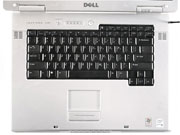 |
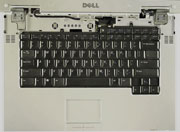 |
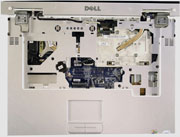 |
| Click to enlarge | ||
The first step in taking apart either of these laptops is to remove the plastic panel at the top of the keyboard area. This can be pried off using a flathead screwdriver, though you'll want to be careful that you don't scratch the finish. (Dell recommends using a plastic tool to pry this off, but we didn't have one available.) Remove a couple of screws at the top of the keyboard and you can lift it out of the way. Before you actually remove the keyboard completely, you will have to disconnect the ribbon cable. Flip up the plastic clamp and the ribbon cable can easily be removed.
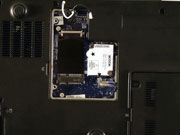 |
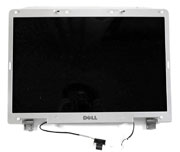 |
 |
| Click to enlarge | ||
Before you get any further into the internals, you need to remove the LCD. The first thing to do is disconnect the integrated WiFi antenna, which is found on the bottom beneath a small hatch. Color-coded wires (one black and one white) are attached to the mini-PCI WiFi card, and after prying these loose (carefully), return to the top of the system, disconnect the main display cable, and remove the four screws that hold the display panel in place.
 |
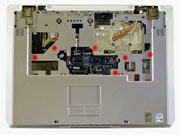 |
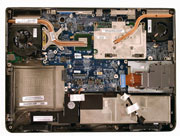 |
| Click to enlarge | ||
The final step before removing the remainder of the cover is to take out the 12 screws on the bottom of the case and six more screws on the top. There are also three cables connecting the cover to the motherboard that you will need to disconnect. Once all of the screws are removed, the plastic cover and trackpad can be removed. Plastic latches help hold the panel in place, so you will need to carefully pry the panel loose, after which you will have access to the CPU and graphics module.
In theory, it is possible to upgrade to graphics module with something faster, but you will need a Dell specific upgrade, and those are not generally available for retail purchase. You might be able to get an upgraded graphics card through Dell Spare Parts, though normally they only send out parts to replace faulty hardware. Perhaps if you have a friend with a better graphics chip that calls in for a replacement GPU....
One area that you can upgrade is the processor, which requires the removal of the heatsink, heat pipes, and fan in the top left of the system. There's not much point in performing this upgrade yourself right now, and we're also not sure how many new processors will be created that can run in these laptops. If it's possible to run Core Duo 2 (Merom) chips in these laptops in the future, that would definitely be interesting, but we have not received any official confirmation from Dell on the matter. You will definitely be able to use Core Solo/Duo chips from the Yonah family, and potentially Merom chips after a BIOS update. Whether such a BIOS update will be released or not is still a matter of speculation.










34 Comments
View All Comments
NullSubroutine - Tuesday, May 30, 2006 - link
In the article the author mentioned the painfulness of disassembling the laptop system, however I disagree. While not being two thumb screws like on some desktops, after taking apart the laptop (which doesnt void your warrenty, as tell had me disassemble so to take the CD/DVD drive in and out to fix a glitch) after a few times, it becomes a breeze. I can take it apart in less than a minute.I would have liked to have seen the comparison of the 7900 GS vs the 7800. As a early i9400 buyer, I was plagued with the 7800 (didnt realize it wasnt the 7800 Go GTX until after it was purchased), there is some good info on i think its called notebookforums or something on how to overclock your gpu with some volt mods. I could get 485/965 on 1.3 volt mod, but it gets hot, and accept a 450/960 on 1.2v (default is 1.1) the 130watt psu helps (I highly recommend) and you should prop up your laptop. I use two 'crystal light cup packs' under each backside pad; I actually perfer it propped as it is easier to type with the backside elevated a bit.
Unfortunetely, dell isnt shipping the 7900 Go GTX, otherwise you could drop that video card right into an older shipping model of the i9400. You can always slightly mod your case and put the 7800 Go GTX in there...but I'm personally gonna wait (and save money) to get the 7900 Go GTX later, or get the 8800 Go GTX sometime later this year if it is released (dell will offer it for the m1710 and it will fit right into the i9400). But this is only if I really decide to droop myself low enough to switch to Vista....shutters....I really hate MS for making DX10 Vista only.
Also, Dell said the Memron will work perfectly (needing at most a bios update) with either laptop.
ElFenix - Tuesday, May 30, 2006 - link
and what pipe configuration does it have?thanks!
JarredWalton - Wednesday, May 31, 2006 - link
20 pixel, 7 vertex (I think), 375/1000 clocks are typical. I'm not positive what the Dell model has on clocks, as there is some variation, but it should still be quite a bit faster than the GF Go 7800. I figure the GF Go 7900 GTX adds another 20-30% in performance, however, as it has even higher clocks (500/1200 with 24/8 pipelines).anandlurker - Tuesday, May 30, 2006 - link
I'm glad that Anandtech include Source DoD for benchmarking, i love this game but when i bought my $300 7800gt just to play this game, the results were mediocre and rather disappointing for this kinda of price. I hope future benchmark from Anandtech include this game, it's a nice simple multiplayer game that seems to render 7800 series useless(pricewise).JarredWalton - Wednesday, May 31, 2006 - link
The fastest scores I've seen on DODS top out at around 67 FPS with audio enabled. (Overclocked FX-62 running 3.08 GHz.) The game is very CPU limited, at least with any reasonable GPU. That said, I find 40 FPS to be very playable on this particular title, though lots of people want higher frame rates.turkster - Tuesday, May 30, 2006 - link
you dont even need the modified INF drivers, the installed Nvidia drivers that came with my M1710 will allow me fix aspect ratio and set scaling options without any problem.For those interested my M1710 (T2500 2Ghz, 2GB RAM) with 7900GS graphics card scored 3805 in 3dmark06 straight out of the box with no tweaks or new drivers etc. This seems a quite respectable score and puts it considerably ahead of the 7800go. I havent done any further benchmarks yet but my experience so far shows that it is quite capable of playing FEAR at 1920x1200 4xAA perfectly smoothly, similarly FarCry and HL2. As such it would seems like quite a good option for those who cant quite stomach the rather steep price of 7900GTX.
JarredWalton - Tuesday, May 30, 2006 - link
So there is an option to do 1:1 scaling - I've removed the paragraph on this. I would have never thought to look in the drivers for this, and it certainly could be placed in a more prominent position. I guess I'm just used to older laptops that did this via BIOS/keyboard shortcuts. (I'm getting old.... LOL)mrSHEiK124 - Tuesday, May 30, 2006 - link
You actually can have the laptop scale resolution while preserving aspect ratio, you just need to install nVIDIA's desktop drivers w/the modified INF that allows them to run on mobile parts and then you can use the scaling settings built into the drivers.ahmshaegar - Tuesday, May 30, 2006 - link
Now I don't know about the Nvidia-based laptops, but I have the Dell Inspiron E1505 (with ATI x1400 Mobility) and to have the aspect resolution preserved when changing resolutions, there's an option in the control panels (both CCC and the old ATI control panels have the option to preserve aspect ratio when changing resolutions.) I'm guessing that it would be the same for Nvidia.Thor86 - Tuesday, May 30, 2006 - link
So, instead of reviewing DTRs, which it seems no-one really cares about, how about a review of ultra-portables?